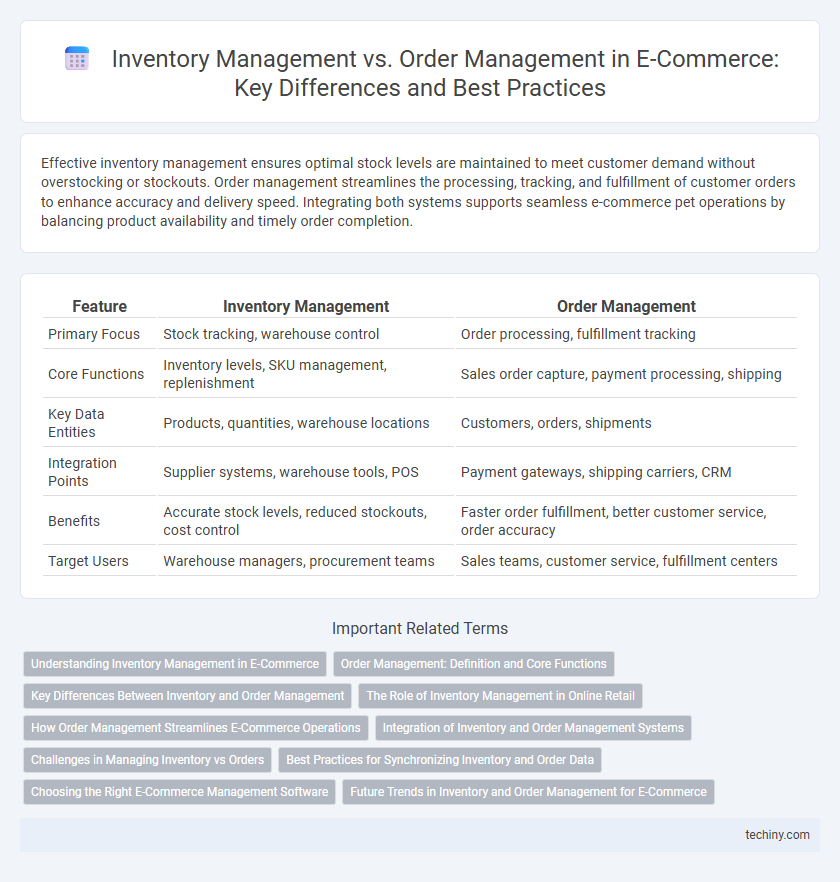Effective inventory management ensures optimal stock levels are maintained to meet customer demand without overstocking or stockouts. Order management streamlines the processing, tracking, and fulfillment of customer orders to enhance accuracy and delivery speed. Integrating both systems supports seamless e-commerce pet operations by balancing product availability and timely order completion.
Table of Comparison
| Feature | Inventory Management | Order Management |
|---|---|---|
| Primary Focus | Stock tracking, warehouse control | Order processing, fulfillment tracking |
| Core Functions | Inventory levels, SKU management, replenishment | Sales order capture, payment processing, shipping |
| Key Data Entities | Products, quantities, warehouse locations | Customers, orders, shipments |
| Integration Points | Supplier systems, warehouse tools, POS | Payment gateways, shipping carriers, CRM |
| Benefits | Accurate stock levels, reduced stockouts, cost control | Faster order fulfillment, better customer service, order accuracy |
| Target Users | Warehouse managers, procurement teams | Sales teams, customer service, fulfillment centers |
Understanding Inventory Management in E-Commerce
Inventory management in e-commerce involves tracking stock levels, managing product storage, and forecasting demand to prevent stockouts or overstock situations. Effective inventory management systems integrate real-time data updates across multiple sales channels to optimize stock availability and reduce carrying costs. Streamlined inventory control enhances customer satisfaction by ensuring timely order fulfillment and minimizing delays in the supply chain.
Order Management: Definition and Core Functions
Order management in e-commerce involves processing customer orders from initiation to delivery, ensuring accurate tracking, fulfillment, and timely shipping. Core functions include order capture, payment processing, inventory allocation, order tracking, and handling returns or exchanges. Effective order management systems improve customer satisfaction by streamlining workflows and reducing errors in the supply chain.
Key Differences Between Inventory and Order Management
Inventory management tracks stock levels, product availability, and warehouse organization to ensure optimal supply. Order management handles customer orders from purchase to delivery, managing order processing, payment, and fulfillment workflows. The key difference lies in inventory focusing on stock control while order management centers on order lifecycle and customer satisfaction.
The Role of Inventory Management in Online Retail
Inventory management directly impacts online retail efficiency by ensuring real-time tracking of stock levels, preventing stockouts and overstock situations. Accurate inventory data supports order fulfillment speed and enhances customer satisfaction, reducing backorders and returns. Integrating inventory management systems with order management platforms optimizes stock allocation, streamlining operations and boosting profitability.
How Order Management Streamlines E-Commerce Operations
Order management streamlines e-commerce operations by automating order processing, tracking inventory levels in real-time, and coordinating fulfillment across multiple sales channels. Efficient order management reduces errors, enhances customer experience through timely updates, and optimizes inventory turnover by syncing stock availability with demand. Integrating order management systems with inventory management ensures seamless data flow, improving operational efficiency and accelerating order fulfillment.
Integration of Inventory and Order Management Systems
Integrating inventory and order management systems streamlines E-commerce operations by providing real-time visibility of stock levels and order statuses, reducing errors and delays. This seamless connection enables automated stock updates, preventing overselling and stockouts while improving fulfillment accuracy. Enhanced data synchronization supports better demand forecasting and optimized inventory replenishment strategies, leading to increased customer satisfaction and operational efficiency.
Challenges in Managing Inventory vs Orders
Inventory management faces challenges such as demand forecasting inaccuracies, stockouts, and overstock situations that impact cash flow and storage costs. Order management struggles with issues like order tracking complexities, multi-channel synchronization, and timely fulfillment to meet customer expectations. Both systems require integration and real-time data accuracy to minimize errors and optimize operational efficiency.
Best Practices for Synchronizing Inventory and Order Data
Efficient synchronization of inventory and order data requires real-time updates across all sales channels to prevent stockouts and overselling, utilizing integrated software solutions such as ERP or OMS systems. Implementing automated inventory tracking combined with order status monitoring ensures accurate stock visibility, reduces manual errors, and enhances customer satisfaction by providing timely fulfillment information. Prioritizing centralized data management and consistent SKU mapping across platforms streamlines order processing and inventory replenishment, optimizing supply chain performance and operational efficiency.
Choosing the Right E-Commerce Management Software
Effective e-commerce management hinges on selecting software that excels in both inventory management and order management, ensuring seamless synchronization between stock levels and sales channels. Inventory management software optimizes stock tracking, demand forecasting, and supplier coordination, preventing stockouts and overstocking. Robust order management systems streamline order processing, fulfillment, and returns, enhancing customer satisfaction and operational efficiency.
Future Trends in Inventory and Order Management for E-Commerce
Future trends in inventory and order management for e-commerce emphasize AI-driven automation for real-time stock tracking and predictive demand forecasting. Integration of blockchain technology enhances transparency and security across supply chain operations, reducing errors and fraud. Advanced omnichannel fulfillment systems optimize order processing efficiency, enabling faster delivery and improved customer satisfaction.
Inventory Management vs Order Management Infographic

 techiny.com
techiny.com